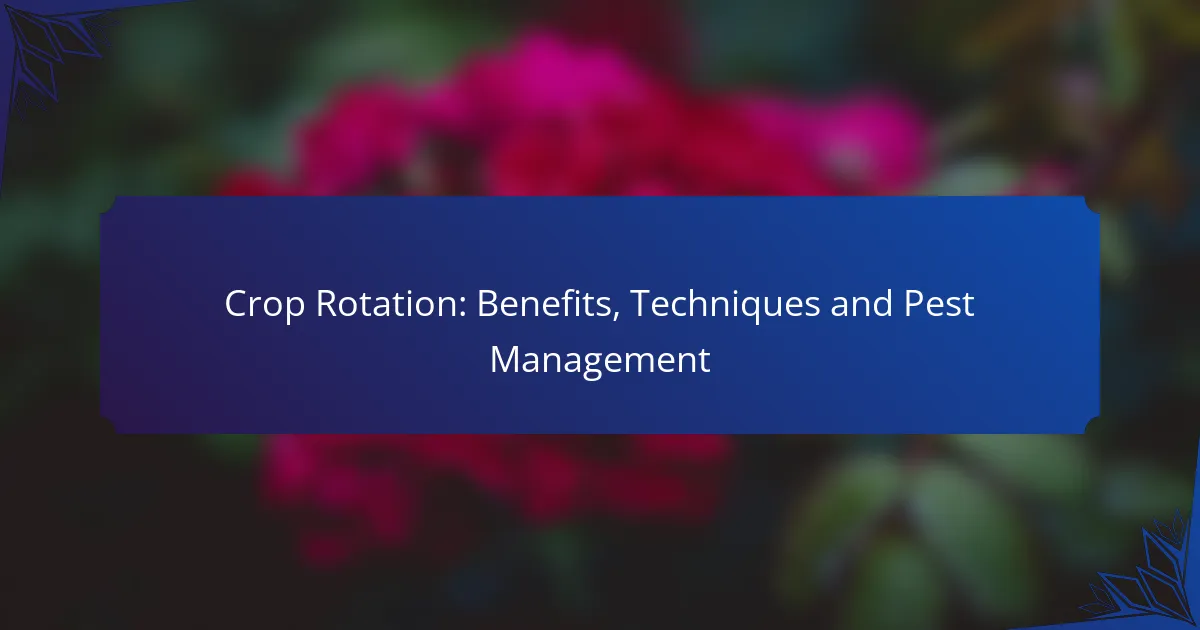Crop rotation is a sustainable agricultural practice that enhances soil health, boosts crop yields, and aids in pest management. By systematically alternating different crops in a given area, farmers can improve nutrient use, reduce soil erosion, and promote biodiversity, ultimately leading to more resilient farming systems.
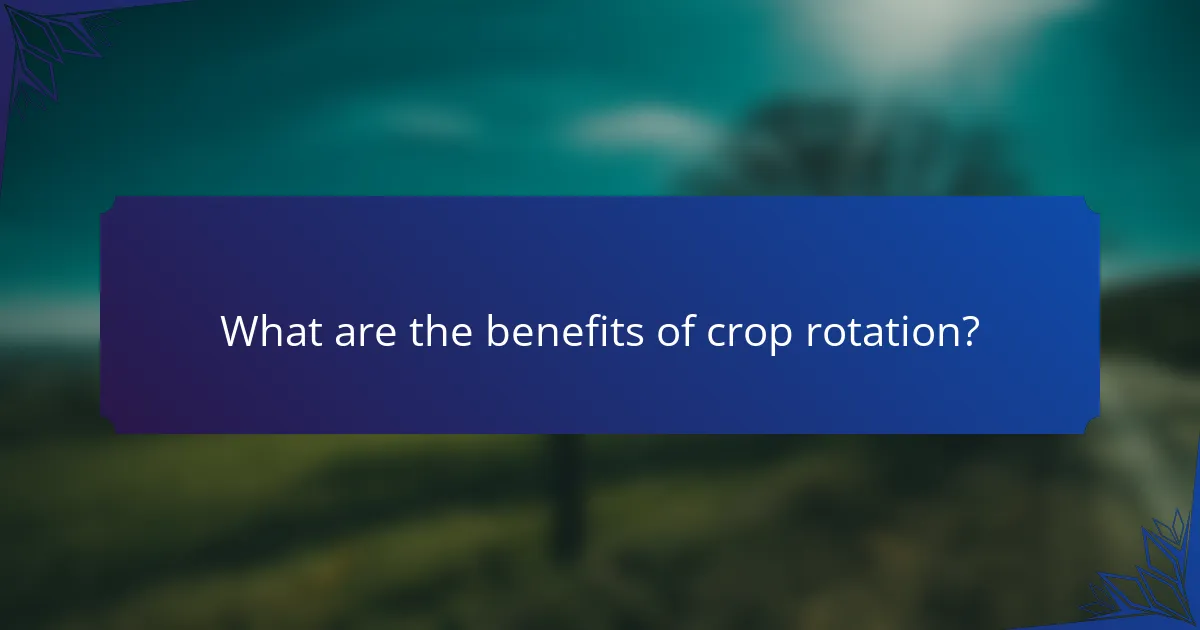
What are the benefits of crop rotation?
Crop rotation offers numerous advantages, including improved soil health, pest and disease control, enhanced crop yields, reduced soil erosion, and increased biodiversity. By systematically alternating the types of crops grown in a specific area, farmers can optimize their land’s productivity and sustainability.
Improved soil health
Crop rotation contributes to better soil health by enhancing nutrient availability and structure. Different crops have varying nutrient requirements and root structures, which can help prevent nutrient depletion and promote soil aeration. For example, legumes can fix nitrogen in the soil, benefiting subsequent crops.
Incorporating cover crops during off-seasons can further improve soil organic matter and microbial activity. This practice leads to healthier soils that are more resilient to environmental stressors.
Pest and disease control
Rotating crops disrupts the life cycles of pests and diseases that thrive on specific plants. By changing the crop type, farmers can reduce the buildup of harmful organisms in the soil. For instance, if a pest is accustomed to feeding on a particular crop, switching to a different family can significantly lower pest populations.
Integrating pest-resistant crops into the rotation can further enhance this effect, providing a natural method of pest management without relying heavily on chemical pesticides.
Enhanced crop yields
Crop rotation can lead to higher overall yields by optimizing the growing conditions for each type of crop. When crops are rotated, they can benefit from improved soil health and reduced pest pressures, resulting in better growth and productivity. For example, rotating corn with soybeans often leads to increased yields for both crops.
Farmers may observe that certain combinations of crops yield better results, allowing them to tailor their rotations based on local conditions and market demands.
Reduced soil erosion
Implementing crop rotation helps reduce soil erosion by maintaining ground cover and improving soil structure. Different root systems stabilize the soil and prevent it from washing away during heavy rains. For example, deep-rooted crops can anchor the soil better than shallow-rooted ones.
Incorporating cover crops in rotation can further protect the soil during fallow periods, minimizing erosion risks and promoting long-term land sustainability.
Increased biodiversity
Crop rotation fosters increased biodiversity by encouraging a variety of plant species in agricultural systems. This diversity can enhance ecosystem resilience, making farms less susceptible to pests and diseases. For instance, including flowering plants in rotations can attract beneficial insects that aid in pollination and pest control.
Moreover, diverse cropping systems can improve habitat for wildlife and promote a balanced ecosystem, contributing to overall agricultural sustainability.
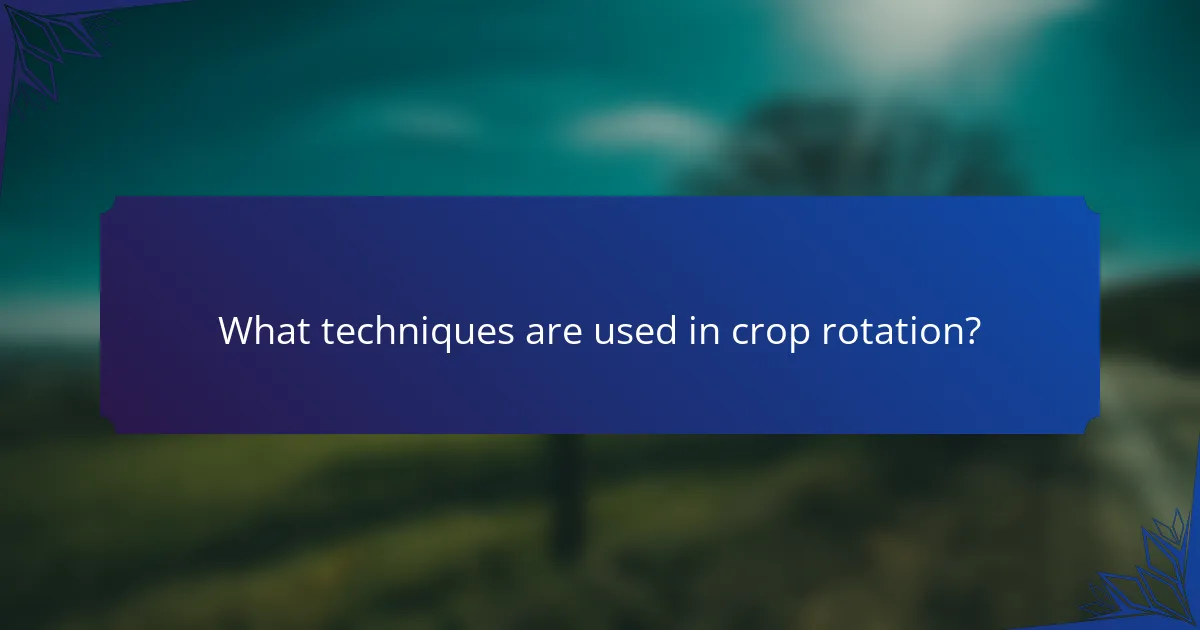
What techniques are used in crop rotation?
Crop rotation involves various techniques that enhance soil health, optimize nutrient use, and manage pests. Key methods include sequential cropping, cover cropping, intercropping, and implementing fallow periods, each offering unique benefits and considerations.
Sequential cropping
Sequential cropping refers to planting different crops in the same field in successive seasons. This technique helps in maximizing land use and can improve soil fertility by alternating deep and shallow-rooted plants. For example, following a nitrogen-fixing legume with a nutrient-demanding crop like corn can enhance yields.
Farmers should consider local climate and soil conditions when selecting crops for sequential planting. It’s crucial to plan planting and harvesting schedules to avoid overlaps that could hinder crop development.
Cover cropping
Cover cropping involves growing specific plants during off-seasons to protect and enrich the soil. These crops, such as clover or rye, prevent erosion, suppress weeds, and improve soil structure. They can also enhance nutrient levels, particularly nitrogen, when turned back into the soil.
Choosing the right cover crop depends on the main crops being grown and local environmental conditions. Farmers should aim to plant cover crops that complement their primary crops and fit within their rotation schedule.
Intercropping
Intercropping is the practice of growing two or more crops in proximity within the same growing season. This technique can lead to better resource utilization, as different plants may have varying nutrient and water needs. For instance, pairing corn with beans can allow for efficient use of sunlight and soil nutrients.
When implementing intercropping, it is essential to select compatible crops that do not compete for the same resources. Farmers should also monitor plant growth to ensure that one crop does not overshadow the other.
Fallow periods
Fallow periods involve leaving a field unplanted for a season or more to restore soil health. This technique can help break pest and disease cycles, allowing the soil to recover its nutrients. It is particularly useful in regions with intensive farming practices that deplete soil quality.
Farmers should consider the length of the fallow period based on soil conditions and crop rotation plans. During this time, they may also implement cover crops to maintain soil structure and fertility.

How does crop rotation manage pests?
Crop rotation effectively manages pests by disrupting their life cycles and reducing their populations. By alternating the types of crops grown in a specific area, farmers can create an environment that is less conducive to pest survival and reproduction.
Disruption of pest life cycles
Crop rotation interrupts the life cycles of pests that are specialized to certain crops. For instance, if a pest thrives on corn, rotating to soybeans or wheat can eliminate their food source, leading to a decline in their numbers. This method can significantly reduce pest populations over time, as they cannot adapt quickly to the new crop environment.
Farmers should plan their rotations strategically, considering the specific pests associated with each crop. A typical rotation might involve planting a legume after a cereal crop, which not only disrupts pests but also improves soil health.
Natural predator support
Crop rotation can enhance the habitat for natural predators of pests, such as beneficial insects and birds. By planting a diverse range of crops, farmers can attract these predators, which help keep pest populations in check. For example, flowering plants can provide nectar and pollen for pollinators and predatory insects.
To maximize this benefit, farmers should include a variety of crops that bloom at different times, ensuring a continuous food source for beneficial species throughout the growing season.
Reduced pesticide reliance
Implementing crop rotation can lead to a decreased need for chemical pesticides. As pest populations decline due to disrupted life cycles and increased natural predation, farmers may find that they can manage pests with fewer or no chemical interventions. This not only reduces costs but also minimizes environmental impact.
Farmers should monitor pest levels and adjust their crop rotation plans accordingly. By integrating pest management strategies with crop rotation, they can create a sustainable farming system that supports both productivity and ecological health.
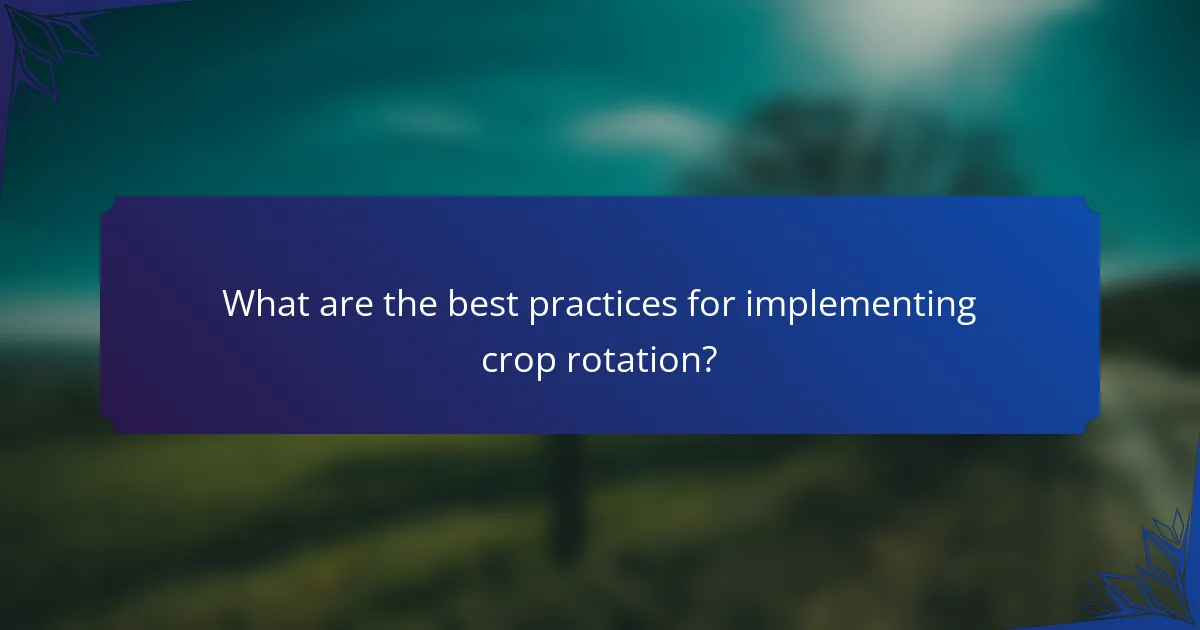
What are the best practices for implementing crop rotation?
The best practices for implementing crop rotation involve careful planning of crop sequences, regular monitoring of soil health, and the incorporation of legumes. These strategies help improve soil fertility, reduce pest populations, and enhance overall crop yields.
Planning crop sequences
Effective crop rotation begins with planning crop sequences that optimize nutrient use and minimize disease risk. Select crops that have different nutrient requirements and growth habits, such as alternating deep-rooted and shallow-rooted plants, to enhance soil structure and fertility.
Consider using a four-year rotation plan that includes a variety of crops like corn, soybeans, wheat, and cover crops. This approach can help break pest and disease cycles while improving soil health.
Monitoring soil health
Regular monitoring of soil health is crucial for successful crop rotation. Test soil for nutrient levels, pH, and organic matter content at least once a year to ensure optimal growing conditions. This information will guide your crop selection and management practices.
Implement practices such as cover cropping and reduced tillage to enhance soil structure and microbial activity. These methods can lead to improved water retention and nutrient availability, benefiting subsequent crops in the rotation.
Incorporating legumes
Incorporating legumes into your crop rotation can significantly enhance soil fertility due to their ability to fix atmospheric nitrogen. This reduces the need for synthetic fertilizers, lowering costs and environmental impact.
Plant legumes such as clover or beans in rotation with cereals or other crops. Aim for a rotation that includes legumes every three to four years to maintain soil health and improve yields.
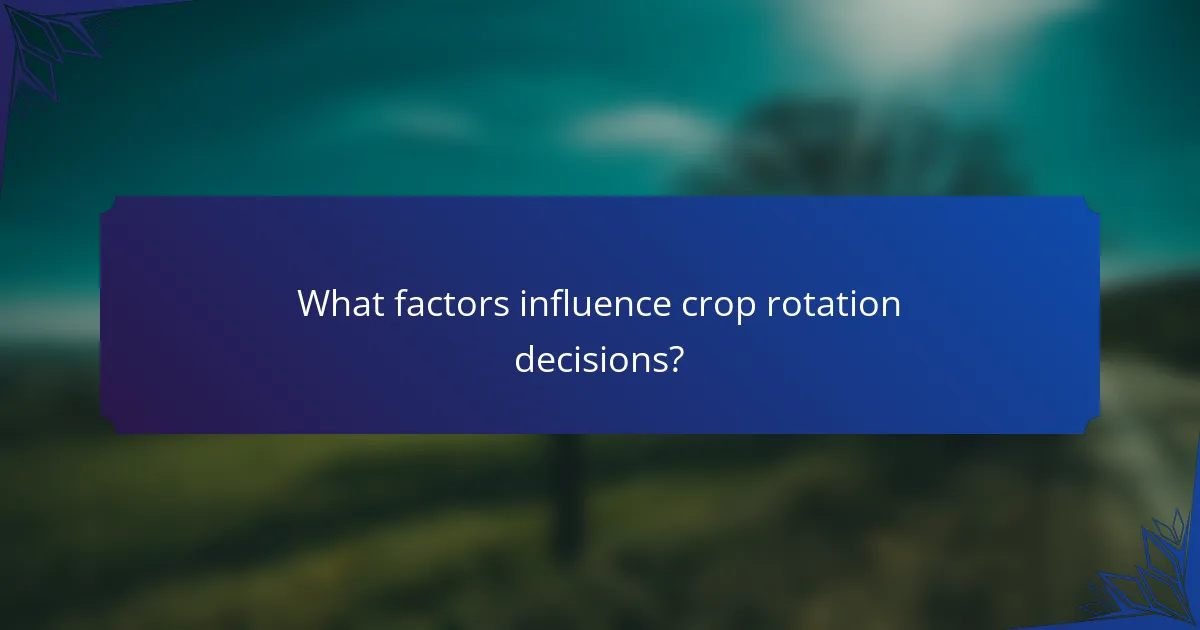
What factors influence crop rotation decisions?
Crop rotation decisions are influenced by several key factors, including soil type and fertility, climate conditions, and market demand for crops. Understanding these elements helps farmers optimize their crop yields and maintain soil health.
Soil type and fertility
The type of soil and its fertility play a critical role in determining which crops to rotate. Different crops have varying nutrient requirements and can affect soil composition differently. For example, legumes can enhance nitrogen levels, benefiting subsequent crops.
Farmers should assess soil pH, texture, and nutrient content before deciding on a rotation plan. Regular soil testing can help identify deficiencies and inform crop choices, ensuring that the soil remains productive over time.
Climate conditions
Climate conditions, including temperature, rainfall, and growing season length, significantly impact crop rotation strategies. Certain crops thrive in specific climates; for instance, corn prefers warm temperatures, while wheat can tolerate cooler conditions.
Farmers should consider local climate patterns when planning rotations. Utilizing drought-resistant varieties or selecting crops suited to the local climate can enhance resilience and yield stability, especially in regions prone to extreme weather.
Market demand for crops
Market demand for crops is a vital factor influencing crop rotation decisions. Farmers often choose to plant crops that are in high demand to maximize profits. This can include cash crops like soybeans or specialty crops that fetch higher prices.
Staying informed about market trends and consumer preferences can guide rotation choices. Engaging with local markets and understanding pricing dynamics can help farmers make strategic decisions that align with both profitability and sustainability.
